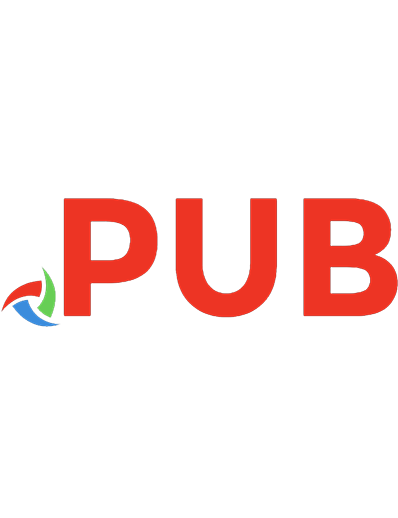Cytopathology [2 ed.] 9780198717362
Biomedical scientists are the foundation of modern healthcare, from cancer screening to diagnosing HIV, from blood trans
579 69 14MB
English Pages 608 [436] Year 2018
Table of contents :
Cover
Contents
An introduction to the Fundamentals of Biomedical Science series
Acknowledgements
Contributors
Abbreviations
1 Introduction: a glance at the past, a glimpse of the future
1.1 What is cytology?
1.2 The development of cytology
1.3 Cytology in the late twentieth and early twenty-first century
Summary
Further Reading
2 Preparation techniques
2.1 Principles and techniques of specimen collection
2.2 The mode of action and effects of cytological fixatives
2.3 Preparation techniques
2.4 Demonstration techniques
Summary
Discussion Questions
3 The cervical screening process
3.1 The basic theory of screening programmes
3.2 Cervical screening
3.3 National Health Service Cervical Screening Programme
3.4 Agencies involved in the NHS Cervical Screening Programme
Summary
Further Reading
Discussion Questions
4 Normal cervical cytology
4.1 Normal anatomy and histology of the female genital system
4.2 Physiology of the female genital system
4.3 Squamous metaplasia
4.4 The cytological features of normal epithelial cells
4.5 Hormonal variations in cervical samples
4.6 Non-epithelial cells in cervical samples
4.7 Microorganisms in cervical samples
4.8 The cytology of inflammation
4.9 Iatrogenic changes
4.10 Criteria for judging the adequacy of cervical samples
Summary
Discussion Questions
5 Abnormal cervical cytology
5.1 Cervical cancer epidemiology
5.2 Squamous neoplasia of the cervix
5.3 Glandular neoplasia
5.4 Cytological pitfalls
5.5 Borderline nuclear changes
5.6 Colposcopy and treatment
Summary
Discussion Questions
6 Quality issues in cervical screening and cytology
6.1 Quality
6.2 Organization of the Cervical Screening Programme
6.3 Quality issues in the call and recall office
6.4 Quality issues in sample taking and primary care
6.5 Quality issues in cytology services
6.6 Quality issues in colposcopy services
6.7 Quality issues in histology services within the Cervical Screening Programme
6.8 Multidisciplinary meetings
6.9 Quality assurance reference centre
6.10 Cervical cancer audit
Summary
Further Reading
Discussion Questions
7 Diagnostic cytopathology
7.1 The general principles of diagnostic, non-cervical cytology
7.2 Nomenclature and classification of neoplastic conditions
7.3 The mechanisms of tumour genesis and metastasis
7.4 Benign processes affecting cell morphology
7.5 The role of cancer multidisciplinary teams
Summary
Discussion Questions
8 Cytology of urine
8.1 Anatomy and histology
8.2 Specimen types
8.3 Sample processing
8.4 Terminology used in reporting urine samples
8.5 Normal voided urine
8.6 Benign findings
8.7 Urothelial neoplasms
8.8 Cytology of urothelial carcinoma
8.9 Iatrogenic changes
8.10 Ancillary techniques
Summary
Further Reading
Discussion Questions
9 Serous effusions
9.1 Anatomy and physiology of serous membranes
9.2 Specimen collection and sample processing
9.3 Reporting terminology
9.4 The cells of effusions
9.5 Neoplastic effusions
Summary
Further Reading
Discussion Questions
10 Lower respiratory tract cytology
10.1 Anatomy and normal cytology of the respiratory tract
10.2 Specimen collection and sample processing
10.3 Reporting terminology
10.4 Assessment of sample adequacy
10.5 Inflammatory and non-neoplastic cytology
10.6 Infections
10.7 Lung cancer
10.8 Cytology of lung cancer
Summary
Further Reading
Discussion Questions
11 Fine needle aspiration cytology
11.1 Principles and technique of fine needle aspiration
11.2 Reporting terminology
11.3 Assessment of sample adequacy
11.4 Case studies
Summary
Further Reading
Discussion Questions
12 Basic semen analysis
12.1 Spermatozoa production
12.2 Semen composition
12.3 Reasons for testing patients
12.4 Specimen requirements
12.5 Laboratory equipment
12.6 Types of sample
12.7 Standard laboratory test for evaluation of semen
12.8 Interpreting the test results
Summary
Further Reading
Discussion Questions
13 Advances in cytopathology
13.1 Automated cervical screening
13.2 Telepathology
13.3 The role of HPV testing and the cervical cancer vaccine
13.4 Future trends in immunocytochemistry
13.5 Flow cytometry
13.6 Molecular techniques
13.7 Application of molecular techniques in cytopathology
Summary
Further Reading
Discussion Questions
Glossary
A
B
C
D
E
F
G
H
I
K
L
M
N
O
P
Q
R
S
T
U
V
W
X
Z
References
Index
A
B
C
D
E
F
G
H
I
K
L
M
N
O
P
Q
R
S
T
U
V
W
Z
![Cytopathology [2 ed.]
9780198717362](https://dokumen.pub/img/200x200/cytopathology-2nbsped-9780198717362.jpg)

![Comprehensive Cytopathology [4 ed.]](https://dokumen.pub/img/200x200/comprehensive-cytopathology-4nbsped.jpg)
![Cytopathology Review Guide [4 ed.]
089189635X, 9780891896357](https://dokumen.pub/img/200x200/cytopathology-review-guide-4nbsped-089189635x-9780891896357.jpg)


![Cytopathology Case Review [1 ed.]
9781617052224, 9781620700594](https://dokumen.pub/img/200x200/cytopathology-case-review-1nbsped-9781617052224-9781620700594.jpg)
![Cytopathology of the head and neck : ultrasound guided FNAC [Second edition]
9781118560815, 1118560817](https://dokumen.pub/img/200x200/cytopathology-of-the-head-and-neck-ultrasound-guided-fnac-second-edition-9781118560815-1118560817.jpg)
![Atlas of Cytopathology: A Pattern Based Approach [1 ed.]
1496397045, 9781496397041](https://dokumen.pub/img/200x200/atlas-of-cytopathology-a-pattern-based-approach-1nbsped-1496397045-9781496397041.jpg)
![The International System for Serous Fluid Cytopathology [1st ed.]
9783030539078, 9783030539085](https://dokumen.pub/img/200x200/the-international-system-for-serous-fluid-cytopathology-1st-ed-9783030539078-9783030539085.jpg)
